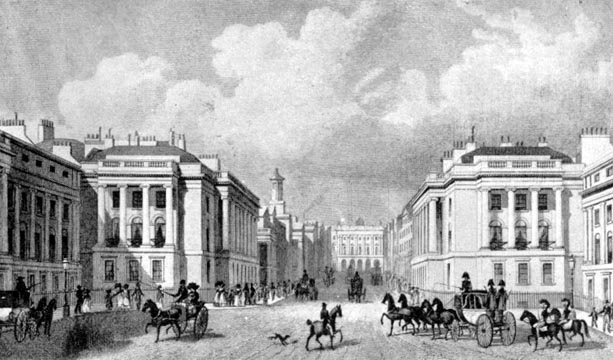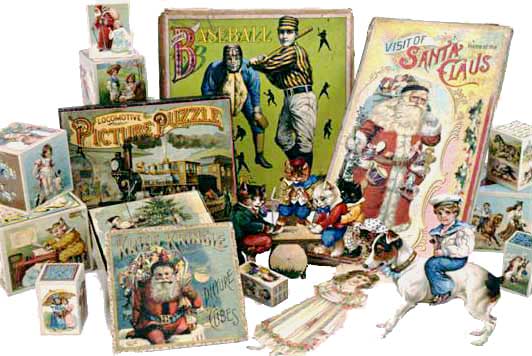Katelynn Vyas
In the article entitled, “Waterloo Place and Her Majesty’s Theatre” by Edward Walford, from the “British History”, Waterloo Place was as complex as Victorian life itself. The layout of Waterloo Place was designed by architect Mr. Nash. It intersects at Pall Mall and is conjoined with Regent Street. Around the year 1815 “low and mean houses” or “filthy dwellings” were demolished to create an area that would later come to be referred to as Waterloo Place and Lower Regent Street. Described as a “spacious” place in which to live and relax, Waterloo Place is perhaps most famous for being connected to Regent’s Park which is described as having “elegant villas, and as being encircled by rows of houses of noble elevation.” It is likely Waterloo Place was a highly appointed location. It had beautiful in architect, timeless design and befitted the upper class (Walford. “British Histories”).
The significance of Waterloo Place in the story “In Dull Brown” by writer Evelyn Sharp, taken from the book entitled The Yellow Book, is Sharp’s description of her “journey” on the omnibus. Sharp, who “is going to teach three children all sorts of things they don’t want to learn a bit”, identifies the stops along the route of the omnibus while in route to Waterloo Place, which includes Green Park and Piccadilly Circus Station. The adjoining areas were designed to accommodate the upper class (Sharp.185). Due in part to its unique configuration, Waterloo Place is what we would consider a “square”. The street and those that intersect it are well appointed with five statues and two large monuments. They include the “Guards Monument” and the “Duke of York” as situated at the end of Waterloo Place and the intersection of Carlton Garden. The five statues depict renowned British figures. They stand in quiet solitude and are: The Sir John Franklin Statue, The Burgoyne Statue, The Lord Lawrence Statue, The Lord Clyde Statue, and The Lord Napier of Magdala Statue (Victorian Google Maps). Waterloo Place is also well-known for the Athenaeum Club, an erudite association that is located across from The United Service Club and a bank.
 Sharp is likened herself to the setting of Waterloo Place. Although the historical significance of the statues is recorded in time, they stand for those who refuse to acknowledge their origins as insignificant details of history. Some individuals find them to be inconsequential and choose not to learn about them. And like the statues who stand in quiet solitude Sharp realizes that on her daily journeys to and from her teaching assignment it is acceptable for her to assume a posture of quiet solitude among the masses with whom she mingles.Sharp is likened herself to the setting of Waterloo Place. Although the historical significance of the statues is recorded in time, they stand for those who refuse to acknowledge their origins as insignificant details of history. Some individuals find them to be inconsequential and choose not to learn about them. And like the statues who stand in quiet solitude Sharp realizes that on her daily journeys to and from her teaching assignment it is acceptable for her to assume a posture of quiet solitude among the masses with whom she mingles.
Sharp is likened herself to the setting of Waterloo Place. Although the historical significance of the statues is recorded in time, they stand for those who refuse to acknowledge their origins as insignificant details of history. Some individuals find them to be inconsequential and choose not to learn about them. And like the statues who stand in quiet solitude Sharp realizes that on her daily journeys to and from her teaching assignment it is acceptable for her to assume a posture of quiet solitude among the masses with whom she mingles.Sharp is likened herself to the setting of Waterloo Place. Although the historical significance of the statues is recorded in time, they stand for those who refuse to acknowledge their origins as insignificant details of history. Some individuals find them to be inconsequential and choose not to learn about them. And like the statues who stand in quiet solitude Sharp realizes that on her daily journeys to and from her teaching assignment it is acceptable for her to assume a posture of quiet solitude among the masses with whom she mingles.

The Athenaeum Club, which appears to the left, is located on the corner of Waterloo Place (Ward. “Victorian Web”). According to the “British Histories” in the article entitled “Pall Mall, South Side, Exiting Buildings: The United Service Club, The Athenaeum”, this scholarly club was established in 1815 and came to fruition in 1825. It was conceptualized by John Wilson Croker as a gathering place for individuals known for their intellectual contributions to British society in the areas of literature, science, artistic accomplishments and who valued patrons of these endeavors. Affiliates were best known for their: inherited prominence, distinguished social positions, and scholarly influence. The club: both in concept and reality was highly efficacious. Other like-minded organizations succeeded the Athenaeum Club and replicated it in principal. The United Service Club was a highly successful army and navy gentlemen’s club that serviced senior officers (“British Histories”).
Works cited
‘Pall Mall, South Side, Existing Buildings: The United Service Club, The Athenaeum.’ Survey of
London: Volumes 29 and 30, St James Westminster, Part 1. Ed. F H W Sheppard. London: London County Council, 1960. 386-399. British History Online. Web. 3 September 2015. http://www.british-history.ac.uk/survey-london/vols29-30/pt1/pp386-399.
Sharp, Evelyn. “In Dull Brown.” The Yellow Book 8 (January 1896): 181-200. The Yellow
Nineties Online.Ed. Dennis Denisoff and Lorraine Janzen Kooistra. Ryerson University,
- Web. 7 September 2015. http://1890s.ca/HTML.aspx?s=YBV8_sharp_dull.html
“Victorian Google Maps.” Victorian GoogleMaps. Google, n.d. Web. 05 Sept. 2015.
Walford, Edward. ‘Waterloo Place and Her Majesty’s Theatre.’ Old and New London: Volume 4.
London: Cassell, Petter & Galpin, 1878. 206-216. British History Online. Web. 8 September 2015. http://www.british-history.ac.uk/old-new-london/vol4/pp206-216.
Ward, Humphry. History of the Athenaeum, 1824-1925. London: Printed for the Club, 1926.
[From the Collection of Professor Ernest Chew, National University of Singapore]
http://www.victorianweb.org/victorian/art/architecture/classical/5.html



